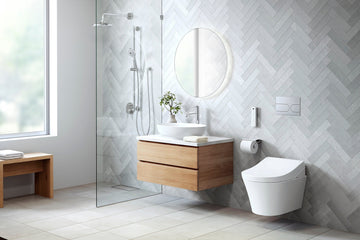The evolution of connected bathroom ecosystems is transforming our daily hygiene routines. These advanced systems integrate smart technology with traditional bathroom fixtures, offering a seamless and enhanced experience. With the growing trend of smart homes, the bathroom is no longer just a utilitarian space. Instead, it has become a hub of innovation and convenience.

What are Connected Bathroom Ecosystems?
In essence, connected bathroom ecosystems refer to the integration of Internet of Things (IoT) technology within bathroom fixtures and accessories. This includes everything from smart showers, toilets, and mirrors to lighting and climate control systems. These devices not only communicate with each other but also connect to broader smart home systems, enhancing user convenience and efficiency.
Benefits of Connected Bathroom Ecosystems
Enhanced Comfort and Convenience
One of the primary benefits of adopting a connected bathroom ecosystem is the enhanced level of comfort and convenience it offers. Imagine a bathroom that adjusts lighting and temperature settings based on the time of day or your personal preferences. Smart mirrors can provide weather updates or reminders while you brush your teeth, and toilets can offer customizable settings for a personalized experience. These innovations are not just about luxury; they are about making everyday routines more efficient and enjoyable.
Improved Water and Energy Efficiency
Smart bathroom systems are designed to optimize water and energy usage, contributing to environmental sustainability. For example, smart showers can regulate water flow and temperature, ensuring minimal waste. Similarly, smart toilets with cloud data storage can monitor and adjust water usage, promoting conservation. This not only reduces the household's ecological footprint but also results in significant cost savings over time.
Challenges in Implementing Connected Bathroom Ecosystems
Privacy and Security Concerns
As with any technology that collects and transmits data, connected bathroom ecosystems raise concerns about privacy and security. Users must be assured that their data, such as usage habits or health information, is protected from unauthorized access. Companies must prioritize data privacy in smart toilets and other devices to gain consumer trust.
Integration and Compatibility Issues
Another challenge is the integration of various devices within a single ecosystem. Different brands and models may not always be compatible, leading to a fragmented experience. Industry standards and protocols are essential to ensure seamless communication between devices. Efforts to address these challenges are crucial for the widespread adoption of connected bathroom ecosystems.
The Future of Connected Bathroom Ecosystems
The future of connected bathroom ecosystems looks promising, with continuous advancements in technology. As these systems become more affordable and accessible, we can expect to see wider adoption in both residential and commercial spaces. Innovations such as customizable toilet settings and entertainment systems in toilets are just the beginning.
Moreover, as more data becomes available, these systems will become even more intelligent, offering personalized recommendations and insights to users. This evolution will redefine our relationship with bathroom spaces, making them not only more functional but also integral to our overall wellbeing.
Conclusion
Connected bathroom ecosystems represent a significant leap forward in the integration of technology and everyday living. By enhancing comfort, efficiency, and sustainability, they offer a glimpse into the future of smart hygiene. For industry professionals, staying informed about these trends is crucial to remain competitive and meet consumer expectations.
To learn more about the latest advancements in smart bathroom technology, consider exploring this external resource.

FAQs
What are the main components of a connected bathroom ecosystem?
A connected bathroom ecosystem typically includes smart devices such as showers, toilets, mirrors, lighting, and climate control systems. These components work together to enhance user experience and efficiency.
How do connected bathroom ecosystems contribute to sustainability?
These ecosystems optimize water and energy usage, reducing waste and promoting conservation. For example, smart showers and toilets adjust flow and usage based on user behavior, leading to significant environmental benefits.
Are there any privacy concerns with connected bathroom ecosystems?
Yes, privacy is a concern as these systems collect and transmit data. Ensuring robust security measures and clear data privacy policies is essential to protect user information.
This article contains affiliate links. We may earn a commission at no extra cost to you.






